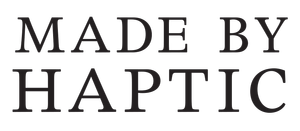our story
ABOUT HAPTIC/ BARBARA SHAUM
A WAY OF MAKING AS A WAY OF RELATING
We started Haptic because we’re following Barbara’s lead -- using what we have to make what we need, with creativity and innovation as our guides. We’re a leather workshop for making long-last- ing things, with attention to detail and traditionally high standards of craft.
As Haptic is a continuation of Barbara Shaum’s shop, it is ever important for us to acknowledge where our approach and craft comes from, here is some information about our heritage:
Barbara Shaum was a craft apprentice to Walter Humphries and Menalkas Duncan. She opened her own shop in the East Village in 1961, and kept her small business going until she passed the torch in 2015. She was known for her leatherwork; custom sandals, bags, belts, wallets and innumerable creative collaborations. Her work lines the archives of some of the best known names in the fashion world; from Eileen Fisher to The Row. However the workshop and her community were what she took pride in. She carried with her traditions that were imbedded in craftsmanship; a relationship with work through the body that enriched and encouraged the mind. Haptic comes from the way Barbara taught. From her, we learned to make things through touch and feel: to listen and let the material speak for itself.
Working in a tradition of crafts is complex in the age of technology. We see this as a benefIt not a hurdle, constantly reflecting on what to let go of and what to keep. To be a maker working in a specific material is to be engaged in collaboration on many levels, in and out of the workshop. We will continue to be visiting tanneries, and wholesalers, touching and seeing the product in its manifold modes of production, and schooling ourselves in the history and intricacies of what it means to work within in the limitations of this specific craft. From learning where and how we can source ethically produced leather and hardware, to finding places for collaboration and conversation, we want to get to know more about how others approach similar problems, or engage in their craft. How can makers relate more to understand the larger issues that making things engages us in. The material one uses is inextricably tied to what one is able to make with it. We want to see what is out there and push the limits of our perception of what’s possible.

